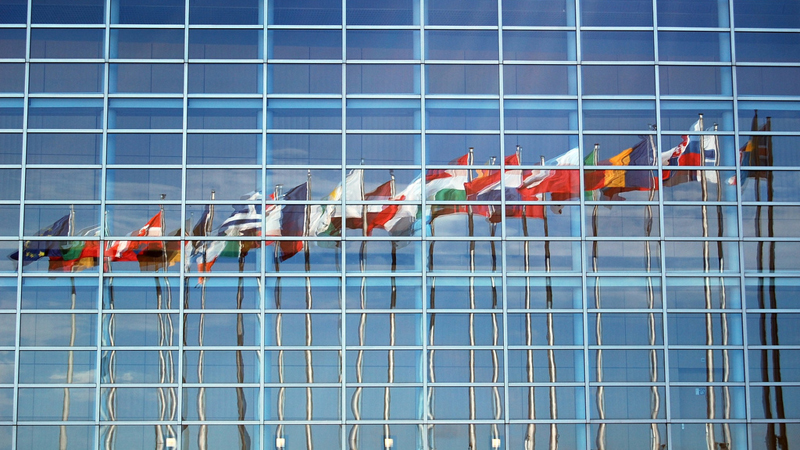Welcomed by the steel lobby and slammed by climate advocates, a package of EU carbon market reforms passed in the European Parliament on Wednesday.
The carbon price stayed still at €5 a tonne as lawmakers voted for a watered down version of proposals put forward by the parliamentary environment committee.
Ian Duncan, the Scottish MEP coordinating the amendments, breathed a sigh of relief, after speculation the plenary might send them back.
Phew! Delighted @Europarl_EN has adopted #EUETS report. My mood is summarised below…@ecrgroup @ConMEPs pic.twitter.com/KafA0Uc0sh
— Ian Duncan MEP (@IanDuncanMEP) February 15, 2017
But the markets were unmoved, as think tank Sandbag was quick to point out through the medium of a Leonardo DiCaprio gif.
Permits are changing hands on the emissions trading system (ETS) at €5 a tonne, which analysts say is too low to drive meaningful investment in clean technology.
And immediately, the #EUETS market reacts to the ‘tough’ reform package…
(price unchanged at €5.08) pic.twitter.com/BOD96cHHBQ
— sandbag.org.uk (@sandbagorguk) February 15, 2017
“This is very disappointing and a hugely wasted opportunity,” said Sandbag managing director Rachel Solomon Williams.
“Unless Council intervenes to substantially strengthen the System, the EU ETS will now become simply an accounting mechanism, leaving meaningful climate action to happen elsewhere. The fact that the carbon price is unchanged as a result of the vote, still at a paltry €5, speaks volumes.”
Environment ministers from member states have an opportunity to influence the package at a meeting on 28 February, before it is finalised.
Weekly briefing: Sign up for your essential climate politics update
The low carbon prices reflect a surplus of pollution permits that has built up since the 2008 financial crisis hit demand – and industry lobbying to keep costs down.
Sectors like steel and cement have successfully argued for carve-outs, on the basis higher costs will drive investment and jobs overseas.
Gareth Stace, director of UK Steel, said of Wednesday’s vote: “The European Parliament should be applauded for finding a balance between the aims of those trying to drive carbon prices higher and the needs of sectors like mine that are trying to compete internationally on tiny margins, often against plants facing none of the same regulatory costs.”
A number of technical decisions went in favour of polluters. A proposal to speed up tightening of the cap on emissions from 2.2% to 2.4% a year next decade was rejected, as was an adjustment to the baseline that could have eliminated up to 2.4 billion tonnes of surplus allowances.
The cement industry will continue to receive free permits, despite evidence producers have reaped a €5bn windfall from handouts to date. Compensation for indirect costs – passed through by power generators – adds another subsidy.
Green groups expressed fury at these compromises, describing them as a betrayal of the international climate deal adopted in Paris in 2015.
“It is shocking that the Parliament chose to bow to the interests of polluting industries instead of protecting citizens from a catastrophic climate breakdown,” said Wendel Trio, director of Climate Action Network Europe.
“The Parliament has completely failed the first test of its commitment to the Paris Agreement. The proposed reforms will keep the carbon market ineffective for a decade or more.
“We urge progressive EU governments to finally turn the ETS into a functioning tool and create a stimulus to ditch old models and move to green economy.”
One measure climate advocates welcomed was the inclusion of international shipping in the system for the first time.
The maritime sector has long argued its climate impact should only be regulated at a global level, but slow progress at the International Maritime Organization has prompted EU lawmakers to propose regional action.
UK envoy: Carbon pricing ‘too sluggish’ to meet climate goals
While it has not lived up to all the hopes invested in it at the outset, the EU ETS is inspiring similar systems elsewhere.
By the end of 2017, as China rolls out a national scheme, the International Carbon Action Partnership estimates 15% of global emissions will be covered by carbon trading.
“Market mechanisms are gaining ground worldwide – Ontario launched its carbon market in January, and China will launch the world’s largest ETS later this year,” said Dirk Forrister, head of the International Emissions Trading Association.
“Europe needs to retain its place at the forefront of the climate battle by establishing the policy framework for the next phase in the 2020s – using the market to deliver the most cost-effective emissions reductions to meet Europe’s objectives.”
Julia Michalak, IETA’s policy director, added: “If the EU ETS isn’t strengthened, Europe risks a proliferation of unilateral national measures that can add inefficiency and increase costs.”
